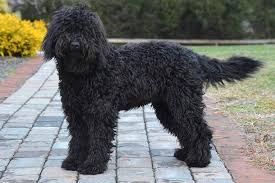Barbet

Description
The Barbet is a breed of dog; it is a medium-sized French water dog. It is listed in Group 8 (retrievers, flushing dogs, water dogs) by the Société Centrale Canine, the French Kennel Club.
The breed name comes from the French word barbe, which means 'beard'.
The Barbet is a rare breed. Most Barbets, especially those shown in conformation shows, are entirely black, black and white, or brown. It is common to see white chest spots and white paws or legs on black or brown coated dogs. Particoloured, cream (or creme), and pied variations are being bred but in limited numbers.
Male Barbets usually grow to be about 21 to 25 in (53 to 64 cm) tall and between 40 and 60 lb (18 and 27 kg), while females usually reach about 20 to 23 in (51 to 58 cm) and 30 to 50 lb (14 to 23 kg).
Appearance
The breed stands 58–65 cm (23–26 in) for the males, 53–61 cm (21–24 in) for females with a tolerance of 1 cm +/- 1 cm (0.39 in), and weighs 17–28 kg (37–62 lb). The Barbet is a prototypic water dog, with a long, woolly, and curly coat.
Their coats grow long and must be groomed regularly, otherwise the coat can become matted and the barbet may lose small tufts of hair like tumbleweeds.
The accepted colours of the breed are solid black, brown, fawn, grey, pale fawn, white, or more or less pied. All shades of red-fawn and pale fawn are permitted. The shade should, preferably, be the same as the colour of the body. Grey and white are extremely rare; mixed colours (except with white) are considered a fault. The most common colors are black or brown with white markings. The birth figures worldwide for 2007 are 176. All born were black or brown some with white markings on the chest, chin, and legs
Temperament
The Barbet’s personality is described as friendly, joyful, obedient, and intelligent. They are quick to learn and need lifelong obedience training. They are a great with children, families, and the elderly. Barbets will bond with their family and prefer to be in the same room with the family at all times. They need exercise daily to keep the dog in a healthy state of mind and body.
They are capable retrievers for waterfowl hunting. In France, the Barbet can take the test d'aptitudes naturelles (TAN), a basic water-retrieving test, and has recently been permitted to participate in the brevet de chasse a l'eau (BCE), a general hunting-dog test involving field and water trials. In Germany, the Barbet takes part in field trials.
Group
Rare
Country Of Origin
France
Size
Color
Solid black, grey, chestnut brown, fawn, pale fawn, white or more or less pied.
Coat
thick, long, woolly, wavy, and curly
Grooming
Brush weekly. Groom as needed.
Life Expectancy
AKC Group
Rare
UKC Group
Height
- Female 53–61 cm (21–24 in)
- Male 58–65 cm (23–26 in)
Weight
- Female 30 - 50 lb (14 to 23 kg)
- Male 40 - 60 lb (18 and 27 kg)
Use Today
Inherited Diseases
Barbets are vulnerable to certain genetic defects. Due to the limited gene pool for this breed, conscientious breeders carefully study pedigrees and select dogs to minimize the chance of genetic diseases. Unfortunately, like many breeds, a growing popularity has encouraged breeding by people who are not knowledgeable about the breed. Of the few health issues that have exhibited themselves; epilepsy, hernias, hip dysplasia and entropion, most problems can be traced back 4–6 generations. Often this was due to limited breeding stock as well as the fact that many matings were with dogs of unknown medical history.
Disease Predispositions
Hip Dysplasia: Like the poodle group of breeds, the Barbet is vulnerable to hip dysplasia. The risk of a Barbet developing the condition can be greatly reduced by thoroughly checking the pedigrees and health clearances in both the sire and dam of the dog.